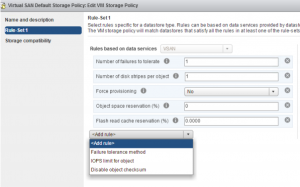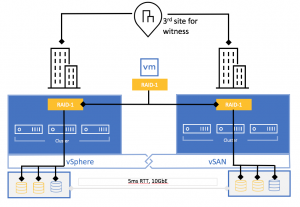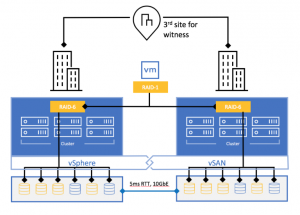Before accepting this page as a reference, I strongly suggest you to review the article I wrote about SPBM again. You can find the page here.

- Stretched Cluster – In Site RAID1
- The data is also written to both sites, and the site is also maintained in RAID1, (3 servers per site)
- Storage Type -> VSAN
- Primary level of failures to tolerate -> 1
- Secondary level of failures to tolerate -> 1
- Failure tolerance Method -> RAID-1 (Mirroring – Performance)

- Stretched Cluster – In Site RAID5
- The data is also written to both sites, and the site is also maintained in the RAID5. (4 servers per site)
- Storage Type -> VSAN
- Primary level of failures to tolerate -> 1
- Secondary level of failures to tolerate -> 1
- Failure tolerance Method –> RAID-5/6 (Erasure Coding) – Capacity

- Stretched Cluster – In Site RAID6
- The data is written to both sites, and the site is also maintained in the RAID6. (6 servers per site)
- Storage Type -> VSAN
- Primary level of failures to tolerate -> 1
- Secondary level of failures to tolerate -> 2
- Failure tolerance Method –> RAID-5/6 (Erasure Coding) – Capacity

- Data Locality Preferred – RAID1
- Data is held on the Preferred site and is maintained as RAID1, and no data is retained on the other site.
- Storage Type -> VSAN
- Primary level of failures to tolerate -> 0
- Secondary level of failures to tolerate -> 1
- Data locality –> Preferred Fault Domain (Stretched)
- Failure tolerance Method -> RAID-1 (Mirroring – Performance)
- Data Locality Preferred – RAID5
- Data is held on the Preferred site and is maintained as RAID5, no data is retained on the other site.
- Storage Type -> VSAN
- Primary level of failures to tolerate -> 0
- Secondary level of failures to tolerate -> 1
- Data locality –> Preferred Fault Domain (Stretched)
- Failure tolerance Method –> RAID-5/6 (Erasure Coding) – Capacity
- Data Locality Preferred – RAID6
- Data is kept on the Preferred site and is maintained as RAID6, no data is retained on the other site.
- Storage Type-> VSAN
- Primary level of failures to tolerate -> 0
- Secondary level of failures to tolerate -> 2
- Data locality –> Preferred Fault Domain (Stretched)
- Failure tolerance Method –> RAID-5/6 (Erasure Coding) – Capacity
- Data Locality Secondary – RAID1
- Data is held on the Secondary site and is maintained as RAID1, and no data is retained on the other site.
- Storage Type -> VSAN
- Primary level of failures to tolerate -> 0
- Secondary level of failures to tolerate -> 1
- Data locality –> Secondary Fault Domain
- Failure tolerance Method -> RAID-1 (Mirroring – Performance)
- Data Locality Secondary – RAID5
- Data is held on the Secondary site and is maintained as RAID5, and no data is retained on the other site.
- Storage Type -> VSAN
- Primary level of failures to tolerate -> 0
- Secondary level of failures to tolerate -> 1
- Data locality –> Secondary Fault Domain
- Failure tolerance Method –> RAID-5/6 (Erasure Coding) – Capacity
- Data Locality Secondary – RAID 6
- Data is held on the Secondary site and is maintained as RAID6, and no data is retained on the other site.
- Storage Type -> VSAN
- Primary level of failures to tolerate -> 0
- Secondary level of failures to tolerate -> 2
- Data locality –> Secondary Fault Domain
- Failure tolerance Method –> RAID-5/6 (Erasure Coding) – Capacity

Yorum yapılmamış
You can leave the first : )